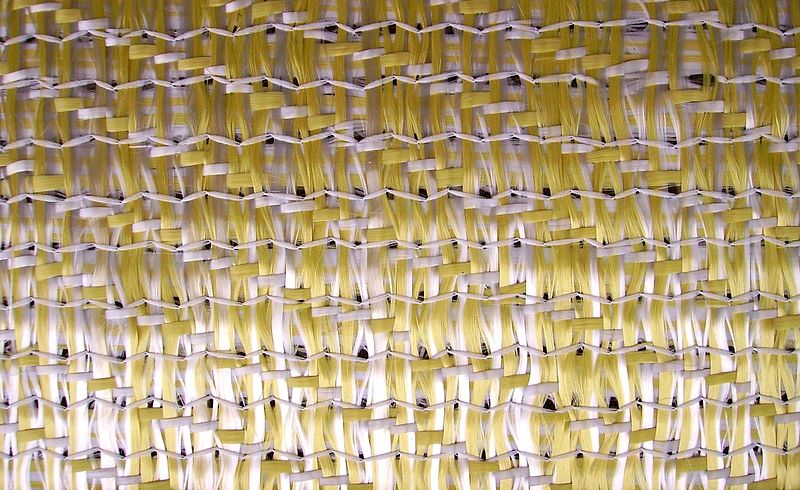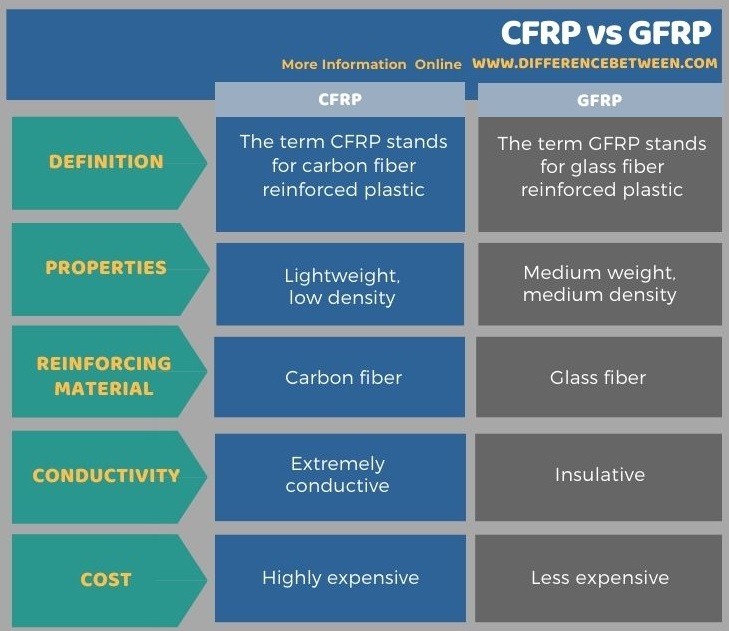Difference Between CFRP and GFRP
The key difference between CFRP and GFRP is that CFRP contains carbon as the fiber component, whereas GFRP contains glass as the fiber component.
The term FRP refers to fibre-reinforced plastic. These are polymers that can be called composite materials, which are made of a polymer matrix that is reinforced with fiber. The reinforcing material differs from one plastic to another. For example, in fiberglass, reinforcing material is glass; in CFRP, reinforcing material is carbon, etc. CFRP and GFRP are two different types of fiber-reinforced plastic materials.
CONTENTS
1. Overview and Key Difference
2. What is CFRP
3. What is GFRP
4. Side by Side Comparison – CFRP vs GFRP in Tabular Form
5. Summary
What is CFRP?
The term CFRP stands for carbon fiber reinforced plastic. These are reinforced polymer composites having a lightweight and high strength. Therefore, these materials are important in manufacturing different products that we use in our daily life. CFRP is a composite material that is reinforced using carbon fiber as the primary structural component.
Generally, CFRPs are thermosetting resins such as epoxy, polyester or vinyl ester. Although CFRP has a very lightweight and a low density, they are much stronger and stiffer per unit weight of the material.

However, there are some disadvantages of using CFRP material. One major drawback is its cost. This is the reason why CFRP is not that much used. The cost of the material varies depending on the current market conditions, type of carbon fiber used for reinforcement, and the fiber to size. Usually, CFRP is expensive, around 5 to 25 times than fiberglass. Other than the cost, conductivity is another drawback of CFRP because carbon fiber is extremely conductive (fiberglass is insulative). However, this property can be both advantageous and disadvantageous occasionally.
What is GFRP?
The term GFRP stands for glass fiber reinforced plastic. This material contains glass as the reinforcing component for the polymer matrix. Compared to other forms of FRP, glass fiber reinforced plastic has comparatively a high density and a medium weight. It is also a strong material. In addition to these, GFRP is less expensive, which allows us to use this material in many applications.

Generally, engine intake manifolds are made from GFRP material. The advantages of using this material include the reduction in weight up to 60%, improved surface quality and aerodynamics, reduction of components by combining parts, ability to form into simple mould shapes, etc. In addition, fiber can be placed in different orientations to withstand stresses, which in turn increases the durability and the safety of the GFRP material.
What is the Difference Between CFRP and GFRP?
CFRP and GFRP are two types of fibre-reinforced materials. The key difference between CFRP and GFRP is that CFRP contains carbon as the fiber component, whereas GFRP contains glass as the fiber component.
Concerning the properties, the difference between CFRP and GFRP is that the CFRP is lightweight and has low density, while the GFRP has a medium weight and medium density. Moreover, CFRP is highly expensive, which limits the use of this material in many applications. Meanwhile, comparatively, GFRP is less expensive and is used where CFRP cannot be used.
The following infographic summarizes the differences between CFRP and GFRP in tabular form.

Summary – CFRP vs GFRP
FRP or fiber reinforced plastic is a polymer material containing a polymer material reinforced with some other component. CFRP and GFRP are two types of fibre-reinforced materials. The key difference between CFRP and GFRP is that CFRP contains carbon as the fiber component, whereas GFRP contains glass as the fiber component.
Reference:
1. Johnson, Todd. “Understanding CFRP Composites.” ThoughtCo, Feb. 11, 2020, Available here.
Image Courtesy:
1. “Drilled hole in carbon fiber reinforced polymer (CFRP) sample” By Andrew Hrechuk – Own work (CC BY 4.0) via Commons Wikimedia
2. “Glass-aramid-hybrid-area used-for-reinforced-plastics” By Photo: User Cjp24; edited by User Jaybear – File Glass aramid hybrid area.jpg (CC BY-SA 3.0) via Commons Wikimedia
ncG1vNJzZmivp6x7pbXFn5yrnZ6YsqOx07CcnqZemLyue8OinZ%2Bdopq7pLGMm5ytr5Wau26vxaunZpmemXqostGpZg%3D%3D